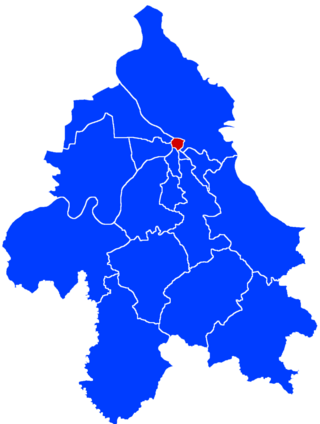
Vračar is an affluent urban area and municipality of the city of Belgrade known as the location of many embassies and museums. According to the 2022 census results, the municipality has a population of 55,406 inhabitants.

Stari Grad is a municipality of the city of Belgrade. It encompasses some of the oldest sections of urban Belgrade, thus the name. Stari Grad is one of the three municipalities that occupy the very center of Belgrade, together with Savski Venac and Vračar.

Senjak is an urban neighborhood of Belgrade, the capital city of Serbia. Located in Savski Venac, one of the three municipalities that constitute the very center of the city, it is an affluent neighborhood containing embassies, diplomatic residences, and mansions. Senjak is generally considered one of the wealthiest parts of Belgrade.

Savinac is an urban neighborhood of Belgrade, the capital of Serbia. It is located in Belgrade's municipality of Vračar.
West Vračar or Zapadni Vračar, is a former urban neighborhood and municipality of Belgrade, the capital of Serbia. It was located in Belgrade's municipality of Savski Venac to which northern section it generally corresponds today.
Karađorđe's Park is a public park and an urban neighborhood of Belgrade, the capital of Serbia. While the park itself is located in Belgrade's municipality of Vračar, majority of what is today considered the neighborhood of Karađorđev Park is since 1957 located in the municipality of Savski Venac.

Žarkovo is an urban neighborhood of Belgrade, Serbia. It is located in Belgrade's municipality of Čukarica.

Skadarlija is a vintage street, an urban neighborhood and former municipality of Belgrade, Serbia, located in the Belgrade municipality of Stari Grad. Skadarlija partially preserves the ambience of traditional urban architecture, including archaic urban organization, and is known as the main bohemian quarter of Belgrade, similar to Montmartre in Paris. Since 1967, Skadarlija has been protected by law as a spatial cultural-historical unit.

Crna Trava is a village and municipality located in the Jablanica District of southern Serbia. According to the 2022 census, the population of the village is 338 inhabitants, while population of the municipality is 1,063. This is the smallest by population and poorest municipality in Serbia.

Mostar interchange or colloquially Mostar is a major interchange and a surrounding urban neighborhood of Belgrade, the capital of Serbia. It is located in Belgrade's municipality of Savski Venac.

Neimar is an urban neighborhood of Belgrade, Serbia. It is located in Belgrade's municipality of Vračar.
Viline Vode is an urban neighborhood of Belgrade, the capital of Serbia. It is located in Belgrade's municipality of Palilula.
Krunski Venac is an urban neighborhood of Belgrade, the capital of Serbia. It is located in Belgrade's municipality of Vračar. In May 2021, the neighborhood was protected as the spatial cultural-historical unit.
Pašino Brdo is an urban neighborhood of Belgrade, the capital of Serbia. It is located in Belgrade's municipality of Voždovac, while the northern section belongs to the municipality of Vračar. It is also known as Lekino Brdo after the top Communist official, Aleksandar Ranković (1909–80), whose nickname was Leka.
Gradić Pejton is an urban neighborhood of Belgrade, the capital of Serbia. Located in Belgrade's municipality of Vračar, it is a unique craftsmen settlement in the city. Gradić Pejton is made of wood, and irregularly shaped in the honeycomb-style to preserve existing trees.

Kalenić is an urban neighborhood of Belgrade, the capital of Serbia. It is located in Belgrade's municipality of Vračar, centered on the Kalenić market, one of the main open greenmarkets in Belgrade.

Vukov Spomenik or colloquially Vuk is an urban neighborhood of Belgrade, the capital of Serbia. It is located on the tripoint of Belgrade's municipalities of Zvezdara, Palilula and Vračar, and served by the underground Vukov Spomenik railway station.

Park Milutin Milanković is a park in Belgrade, a capital of Serbia. It is situated on top of the Vračar hill, in the municipality of Savski Venac and was the former location of the Belgrade Observatory from 1891 to 1929. Before it was named after scientist Milutin Milanković in 2010, it was known as Old Zvezdara.

The Building of the Patriarchate is a building in Belgrade, the capital of Serbia. It is the administrative seat of the Serbian Orthodox Church and its head, the Patriarch of the Serbian Orthodox Church. Finished in 1935, the building was declared a cultural monument on 18 December 1984.

The vibrant and dynamic nightlife in Belgrade achieved international prominence in the early 21st century. Belgrade, the capital of Serbia, gained a reputation both due to the traditional nightlife, mostly represented by the kafanas, and the contemporary, modern nightlife, especially including splavovi, barges and floats adapted into the clubs and cafés. Belgrade often makes the lists of the cities with best clubbing and partying, discreetly shaping itself into the fun and accommodating metropolis.
















